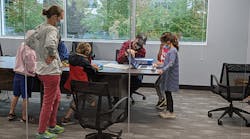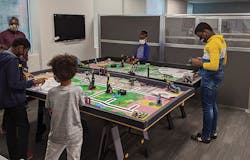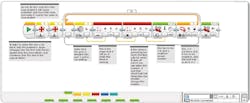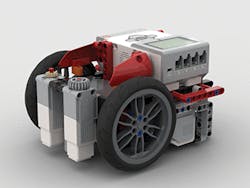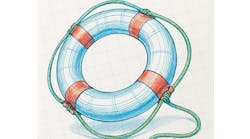Imagine peering proudly toward the stage on a Saturday afternoon as a competition is wrapping up, with a row of students posing for the cameras and centering their robot and trophy in the frame. It feels like only recently that the young crew came together and, awkwardly at first, began querying each other on how much torque is required for a robot arm to hoist a block through a hoop. Today, this team and others have gathered in the spirit of cooperative competition to learn life and career skills while having fun.
This day was made possible by volunteer coaches who facilitated conversations about sensors, inputs and outputs—along with school and career advice—helping these students grow as a team and as individuals. These developing, young engineers, gaining newfound self-sufficiency, provide confidence that the next generation will bring about a better world. The efforts of coaches and sponsors result in a positive impact on these students.
Reaching a new generation of engineers, scientists and makers is more important than ever for industrial automation due to an aging workforce with a disproportionately low number of new skilled workers to take the place of retirees.
To answer this call and to serve the community, Tesco Controls provides its office-space as the Build Zone for Swerve Robotics student teams to engage in the FIRST Lego League (FLL), enriching young lives and preparing these students for success in the fields on which much of our modern society depends.
FIRST Robotics
The international For Inspiration and Recognition of Science and Technology (FIRST) organization manages three curriculums—FIRST Robotics Competition, FIRST Tech Challenge and FIRST Lego League—each encouraging creativity and innovation among teams of students. FIRST Lego League empowers six- to 14-year-old groups to accomplish real-world tasks by designing, constructing, programming and operating robots.
FIRST core values emphasize teamwork, respect for others, learning technical and soft skills, community involvement, and fostering a culture of equity, diversity and inclusion as reflected in the organization’s vision and mission statement:
- Discovery: We explore new skills and ideas.
- Innovation: We use creativity and persistence to solve problems.
- Impact: We apply what we learn to improve our world.
- Inclusion: We respect each other and embrace our differences.
- Teamwork: We are stronger when we work together.
- Fun: We enjoy and celebrate what we do!
This is all about being gracious in alignment with human progress and helping those in need. At the competition, students make sure all teams get a chance to compete, so at the end of the day the top team is called on stage because they earned their win in a fair contest.
Swerve-ing into FIRST
After identifying a need to help parents coach their children more effectively, a FIRST team coach in the Northshore school district of the Bothell, Wash., region founded Swerve Robotics. While most FIRST teams around the world form and meet seasonally near competition time, Swerve Robotics is providing longevity for FIRST teams, and giving students whose parents aren’t able to coach the opportunity to participate.
Swerve Robotics is community-based—not school-based—with adult community members taking an interest in coaching, such as engineers at Tesco Controls. Coaches who aren't team member parents often gives students a greater chance to grow.
At Swerve Robotics, students manage the technical projects and budgets for constructing robots to perform tasks. Coaches are encouraged to remain as hands-off as possible to let students run the show, while stepping in to facilitate ideas when students hit roadblocks and to keep creative ideas flowing. This helps the teammates develop as problem solvers (Figure 1).
There is often a desire among technical and engineering professionals to volunteer in their communities, but many aren't sure where to look and how to give back. Swerve Robotics is helping these individuals connect and contribute in meaningful and impactful ways.
Swerve Robotics is also establishing a presence in communities outside of the U.S., particularly focusing on regions with limited access to science, technology, engineering and math (STEM) learning. This is positively impacting under-privileged communities, while providing students from Swerve Robotics U.S. with the chance to pay their opportunities forward. To ensure any interested student has a chance to participate, Swerve Robotics provides scholarships to those who otherwise would be unable to afford participation in FIRST.
Figure 2: The Tesco Build Zone provides students and coaches an environment to team-build, brainstorm, develop and let creative ideas flow.
While Swerve Robotics has developed a strong presence through ambition, direction and helpful volunteers stepping up in the community, competitors need productive spaces in which to work and coach. This is how industry leaders like Tesco lend their support. When Tesco learned about Swerve Robotics and the need for such spaces, it offered to provide a portion of its offices for the young innovators.
Tesco’s involvement: the Build Zone
Not only does the Tesco Build Zone provide a focused space for students and coaches to meet, create and innovate—it also makes the experience seem more real because students can see the direct real-world applicability of what they're doing.
Much like engineering teams, Swerve Robotics teams meet once or twice a week at the Build Zone for discussions, plus robot design and programming. Because the Tesco space permanently houses the Build Zone and students’ work-in-progress, students can concentrate on creativity instead of set-up and tear-down at each meeting (Figure 2).
The sight of Lego robotic creations in the Build Zone generates intrigue for vendors and other visitors to Tesco’s office during the course of daily business interactions. This office environment exposes students to engineering and science in the real world at a young age, bringing them together with adult mentors working in industry who they can learn from.
The Lego Mindstorms programming platform used by Swerve Robotics teams is similar to a programmable logic controller's (PLC) development software interface, making real-world applicability evident. Particularly reminiscent of PLC function block diagram programming, Lego NXT, EV3 and Spike programs are set up like logic flow charts through blocks, with calculations performed in each block. Each block accepts inputs and operates on those according to an algorithm to produce outputs passed to another block (Figure 3).
Figure 3: Lego Mindstorms EV3 program code for a team's robot closely resembles PLC function blog diagram programming.
Each sensor or physical robot device has an address in the software, like industrial control input and output PLC tags. Just as with good PLC programming practices, students are taught to record thorough comments in their code.
The partnership works out well for Tesco and Swerve Robotics. Tesco is hiring students from Swerve Robotics as interns this summer, and staff are eager to work with budding engineers.
The Build Zone was especially beneficial to Swerve Robotics in the past year. During COVID-19, most FIRST teams met online only, but the space allocated at the Tesco facility allowed for social distancing, providing Swerve Robotics teams the ability to safely meet on a regular basis. In-person group activities enhance communication and make a real difference in students’ opportunities to grow as a cohesive team.
Figure 4: After multiple iterations and a spreadsheet full of robot run results, this final robot version is ready for competition.
Culmination in competition
Teambuilding, designing, programming and development lead up to the crowning moment for these students, which is participating in cooperative competition—"coopertition"— with their peers at the annual contests. At these competitions, teams are given “missions,” and they must decide which they will attempt to accomplish in the two-and-a-half minutes available to run robot tasks.
Each mission contains objectives, alongside limitations on construction, such as a maximum number of motors or sensors allowed. Robots are inspected prior to competition to ensure compliance with mechanical constraints (Figure 4).
Following prerequisite inspections, robots are assessed based on objectives accomplishment, on the robot and component process and industrial design, and on the team’s presentation of their robot to a panel of judges. Innovative solutions and demonstration of FIRST’s core values factor positively into teams’ scores, along with consideration whether everyone on a team contributed. If one or two students on a team hog the spotlight, it can reduce their total team score, parallel to the negative real-world impact when business team member contributions are left unheard.
Because coaches and mentors are on the sidelines during competitions, outcomes are driven solely by the students. This emphasizes the importance of encouraging students to be self-starters and collaborative problem solvers with each other during robot meetups throughout the year.
Industry-innovator interdependence
Flashing back to the student team on stage, crowding into a huddle for the victory photo, one is reminded that while their success is their own doing, it wouldn't be possible without positive role models, mentors and facilitators along the way. This is why partnerships between organizations like Swerve Robotics and Tesco are critical; they open doors for young innovators to learn essential team-building and problem-solving skills, and they provide avenues for industry professionals to share their expertise.
The partnership with Tesco is helping Swerve Robotics preserve its presence in the community and expand its reach, providing a diverse group of students the opportunity to participate in creative teams. Already solving real-world problems through robotics at an early age, the sky is the limit on what these young engineers will think up during their lifetimes.
Behind the byline
Michael Smith, P.E., is the Tesco Washington regional lead. He is a registered controls engineer and certified software developer with more than 26 years of experience in the planning, design, testing, implementation and operations of control systems for water and wastewater treatment plants and associated infrastructure. Heidi Lovett is the founder and executive director for Swerve Robotics. She formed a FIRST Lego League team for her sons and discovered the life-changing fun of FIRST. She has a bachelor’s degree in theatre. Sara Jones joined Swerve Robotics as a parent four years ago, and has eight years of experience with FIRST. She very quickly became involved and joined the board as well as becoming the FLL Director to help grow and develop the program.

Leaders relevant to this article:
